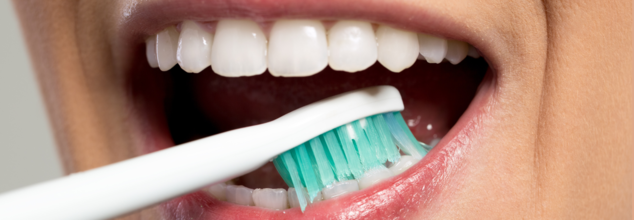- Health Conditions A-Z
- Health & Wellness
- Nutrition
- Fitness
- Health News
- Ayurveda
- Videos
- Medicine A-Z
- Parenting
- Web Stories
Weeks or Months: How Often Should You Change Your Toothbrush?

Weeks or Months: How Often Should You Change Your Toothbrush?
Maintaining oral hygiene is a daily commitment which involves brushing twice a day, flossing, and using quality toothpaste. However, one crucial aspect of dental care is knowing how often to replace your toothbrush. For removing plaque or debris, your toothbrush cannot be relied on forever due to effectiveness loss over a period of time. So how frequently should you change your toothbrush, and why is it important?
Manufacturers and dental experts agree that toothbrushes should be changed in approximately 12 to 16 weeks. However, the individual situation, such as brushing pattern and type of toothbrush, may change this timeline. Manual toothbrushes and electric toothbrush heads both tend to wear out eventually, but the time to their replacement is slightly different for each.
For most people, oral healthcare providers recommend changing a toothbrush every three to four months. This frequency ensures the bristles remain effective in cleaning plaque and preventing oral health issues like gum disease and tooth decay.
Why It Is Important To Replace Your Toothbrush Regularly
Your toothbrush is the first barrier to the bacteria causing gum diseases, cavities, and halitosis. Over time, bristles become frayed and lose their stiffness, causing them to fail in doing the job they are assigned to do. In addition to this, the toothbrush may harbor bacteria, saliva, and food particles, thus posing a risk to oral health if not changed regularly.
Failure to replace a worn-out toothbrush can lead to a buildup of plaque and bacteria, which can create a risk for gingivitis and tooth decay. Gingivitis is the initial stage of periodontal disease, and it affects around 80% of all adults in the United States. Prevention of this typical problem starts with a toothbrush that functions properly.
How Often Should You Change or Replace Your Toothbrush
Manual Toothbrushes
For traditional toothbrushes, the recommended replacement period is three to four months. This timeline ensures that the bristles remain intact and effective. Research indicates that brushing technique plays a significant role in bristle wear, meaning that even a newer toothbrush may require replacement if used improperly.
Electric Toothbrushes
Electric toothbrushes, which clean teeth through rapid vibrations or rotations, typically have shorter bristles than manual ones. This makes their bristles more prone to wearing out faster. The American Dental Association recommends changing the brush head every three months or sooner if it shows signs of wear.
When to Change Your Toothbrush After Illness
There are times when you should change your toothbrush earlier than the three-month mark:
After Sickness
If you or a family member have been ill, it is best to replace toothbrushes to avoid the spread of bacteria and viruses. Streptococcal infections can remain on bristles, so it is safer to start fresh.
Children's Toothbrushes
Children's toothbrushes tend to need to be replaced more often because they tend to chew on bristles or handles, which wears them out faster.
Dangers of Using an Old Toothbrush
Several side effects exist to using a worn out toothbrush on your dental oral hygiene:
Reduced Cleaning Efficiency
Dirty or blunt brushes are incapable of successfully dislodging plaque.
Increased Risk Of Tooth Decay
Bad clean results in an increased plague building that eventually develops in forming cavity.
Gum And Gingivitis Development
It causes the inflammation around gum which eventually progresses for deeper disease.
Ways to Care For Your Toothbrush
To increase the lifespan of your toothbrush and ensure its hygiene, there are a few simple care tips that can be followed:
- Do Not Share: Sharing a toothbrush can transfer bacteria and increase the risk of infection.
- Rinse Thoroughly: After every use, rinse your toothbrush under running tap water to remove debris.
- Avoid Soaking: Do not soak your toothbrush in mouthwash or disinfectant solutions, as this can spread bacteria.
- Store Properly: Store your toothbrushes upright and open. Closed containers can foster mold and bacteria. Do not allow heads to touch if you store multiple in one place for cross-contamination.
You Are Much Less Likely To Get Opioid Prescriptions For Lower Back Pain Than Before- Is Healthcare Getting Better?

(Credit-Canva)
Emergency rooms are handing out significantly fewer opioid prescriptions to people experiencing lower back pain. Researchers reported in the Annals of Emergency Medicine on July 12 that the rate of opioid prescriptions for back pain in ERs dropped by more than half between 2016 and 2022.
Dramatic Decline in Opioid Prescribing
Just a few years ago, in 2016, almost one out of every three visits to the ER for back pain ended with a prescription for opioid painkillers. But by 2022, that number had fallen dramatically to just over one in ten visits. This big drop means that doctors are learning from the available information and changing the way they practice medicine, especially as more people become aware of the widespread problems caused by opioid addiction. It's a positive sign that medical professionals are actively working to curb the opioid crisis.
Understanding the Study and Patient Experience
To figure this out, researchers looked at records from nearly 53 million ER visits for low back pain that happened between 2016 and 2022. These records were gathered by a national health statistics centre. The study found that when people went to the ER for back pain, they were usually in a lot of discomfort, rating their pain at more than 7 out of 10. On average, they had to wait about 37 minutes before a doctor saw them and spent around four hours in the emergency room getting treatment.
Why Opioid Usage Is Risky For Patients
A 2023 study even found that opioids may not be as effective for back pain. Published in the JAMA network, a 2023 study conducted a trial on those who were experiencing back pain. The trial involved 347 adults who had been experiencing pain for up to 12 weeks. Everyone in the study received standard care, which included reassurance, advice to avoid bed rest, and encouragement to stay active. Half of the participants also received a combination of oxycodone and naloxone (an opioid), while the other half received a placebo (a dummy pill).
The study also revealed that while side effects were similar for both groups, there was a significant difference in the risk of opioid misuse. One year later, 20% of the participants who took opioids were at risk of misusing them, compared to only 10% of those who received the placebo. This suggests that even for short-term pain relief, opioids carry a greater risk of future misuse.
NSAIDs Emerge as Preferred Treatment
Now, when you go to the ER with low back pain, nonsteroidal anti-inflammatory drugs, often called NSAIDs (like ibuprofen), are the most common painkillers prescribed. They're given to almost 29% of patients. It's not just about prescriptions either; fewer patients are actually given opioids while they are being treated in the ER. That number went down from 35% of cases in 2016 to less than 25% by 2020, showing a clear shift away from immediate opioid use during emergency care for back pain.
Next Issues People Must Tackle
Even though there's good progress with reducing opioids, ER doctors still have some areas where they could improve how they treat back pain. For example, many patients with back pain are still getting X-rays that they don't really need. In 2022, about 37% of patients had an X-ray, which is pretty much the same as in 2015. In fact, in 2021, almost 44% of cases involved an X-ray, which was the highest rate. It's tough to get this number down because deciding whether to order an X-ray can be complicated and depends on what both the doctor and the patient think is best.
AI Can Now Help Identify Diabetic Eye Disease That Can Destroy Your Vision For Life

(Credit-Canva)
Doctors may soon have a powerful new tool to help catch a serious eye disease caused by diabetes. Researchers have created an AI-powered retina tracker that is incredibly accurate at finding diabetic retinopathy, a condition that can lead to blindness. In a news release by the Endocrine Society, researchers detail how this new AI technology revolutionizes health and eye care, bringing it to the next level.
Fast, Accurate, and Accessible Eye Screening
This new program, called the Simple Mobile AI Retina Tracker (SMART), showed over 99% accuracy in its ability to screen for diabetic retinopathy. This impressive result was announced recently at a medical conference.
SMART uses advanced AI to quickly and accurately look at images of the retina – the light-sensing part at the back of your eye. What makes it truly special is that it can work on any device with internet access, even basic smartphones.
This means eye specialists can screen patients more easily and quickly. It also allows general doctors to include eye exams during regular visits. Most importantly, it helps bring high-quality eye checks to places where there aren't many eye doctors.
Tackling Diabetic Retinopathy
Diabetic retinopathy is a condition where tiny blood vessels in the eye leak and damage the retina. It's a major cause of blinedness that could be prevented, affecting over 100 million people worldwide.
To develop SMART, researchers trained the AI using thousands of retinal images from a diverse group of patients across six continents. When they tested the AI on new images, it could detect diabetic retinopathy almost every time, processing each image in less than one second. The tracker could also tell the difference between diabetic retinopathy and other eye conditions.
Symptoms And Issues Associated With Diabetic Retinopathy
According to the US National Eye Institute, Diabetic retinopathy is an eye problem that can affect anyone with diabetes. It happens when high blood sugar damages the tiny blood vessels in your retina, the light-sensing part at the back of your eye. Early detection and managing your diabetes are key to protecting your vision.
Diabetes harms blood vessels throughout your entire body. In your eyes, this damage begins when high blood sugar changes the tiny blood vessels that feed your retina. These changes make it harder for blood to flow, leading to some blood vessels getting blocked or starting to leak fluid or blood.
Warning Signs
In its early stages, you usually won't notice any problems with your vision. However, some people might notice subtle changes, like difficulty reading or seeing things far away. These changes might even come and go.
As the condition gets worse, blood vessels in your retina can start to bleed into the jelly-like fluid that fills your eye. If this happens, you might see dark, floating spots or streaks, almost like cobwebs. Sometimes these spots clear up on their own, but it's crucial to get medical help right away. If left untreated, scars can form at the back of your eye, or the bleeding might start again or get worse.
Who Will This New AI Help?
Developing this new AI has the potential to make eye care available to a vast number of people globally, simply by using mobile technology. Experts believe this innovation could screen billions worldwide, significantly cutting down vision loss from diabetic retinopathy. It could also completely change how healthcare is provided.
Anyone with diabetes can get diabetic retinopathy, whether they have type 1, type 2, or gestational diabetes (diabetes that develops during pregnancy).
Your risk goes up the longer you've had diabetes. In fact, over half of people with diabetes will develop diabetic retinopathy eventually. The good news is that you can significantly lower your risk by keeping your blood sugar levels under control.
Women with diabetes who become pregnant, or those who develop gestational diabetes, are at a higher risk. If you have diabetes and are pregnant, you should get a full eye exam with dilated pupils as soon as possible.
This research highlights how AI can be a positive force, helping to bridge gaps in medical care and offering hope to millions who are at risk of losing their sight.
Most Common Cause Of High Blood Pressure May Be The Most Overlooked One - New Guidelines Reveal

(Credit-Canva)
It is not uncommon for doctors to misidentify a health condition or misdiagnose due to lack of information or conflicting symptoms. However, many times these mistakes can lead the patient to get the wrong treatment, and cause problems like prolonged treatment, more health problems as well as patients feeling unheard.
A new report suggests that doctors are often missing a common, hormone-related reason for high blood pressure. This overlooked condition, called primary aldosteronism, could be affecting a significant number of people with high blood pressure without them even knowing. According to a study published in the Journal of Clinical Endocrinology & Metabolism, most doctors fail to identify this condition, even though it is the most common cause of high blood pressure.
More Common Than Thought
Research shows that as many as 30% of high blood pressure patients seen by heart specialists, and 14% of those seen by general doctors, actually have primary aldosteronism. This condition occurs when the adrenal glands (small glands located on top of your kidneys) produce too much of a hormone called aldosterone.
Despite how common it might be, many people with high blood pressure are never given a simple blood test to check for primary aldosteronism. In other cases, they might finally be tested years after their high blood pressure diagnosis. By this time, the condition can already lead to serious health problems.
Misdiagnoses in other health problems are also very common. According to a 2023 study published in the JAMA journal, every year, a staggering number of people—around 795,000—either die or are left with permanent disabilities because of mistakes in their diagnosis or related issues in healthcare. Even with a more conservative estimate, the number is still very high, at about 549,000 people harmed.
Why Is It Important to Diagnose?
People with primary aldosteronism face a higher risk of heart and blood vessel problems compared to those with regular high blood pressure.
Aldosterone helps control the balance of sodium (salt) and potassium in your blood. When aldosterone levels are too high, your body can lose too much potassium and hold onto too much sodium, which directly leads to higher blood pressure. Studies have shown that individuals with primary aldosterosteronism are:
- Nearly 2.6 times more likely to have a stroke.
- Twice as likely to experience heart failure.
- 3.5 times more likely to develop an irregular heartbeat.
- 77% more likely to end up with heart disease.
A simple and inexpensive blood test could help identify more people with primary aldosteronism, ensuring they get the right treatment.
New Guidelines and Treatment Options
The new report suggests that everyone diagnosed with high blood pressure should have their aldosterone levels checked. If primary aldosteronism is found, specific treatments for that condition should be given.
There are prescription medications available to treat primary aldosteronism. These include drugs like spironolactone and eplerenone, which help lower blood pressure and increase potassium levels in the body.
Doctors might also recommend surgery to remove one of the two adrenal glands if only one gland is making too much aldosterone. Patients are also usually advised to follow a balanced low-sodium diet and try to lose weight to help manage the condition.
© 2024 Bennett, Coleman & Company Limited

